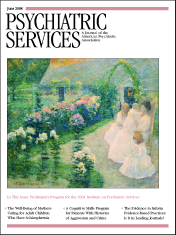Variations in Use of Second-Generation Antipsychotic Medication by Race Among Adult Psychiatric Patients
Abstract
OBJECTIVE: This study examined variations in the use of second-generation antipsychotic medication among African-American and non-Hispanic white patients in a national sample of adults who were treated by psychiatrists. METHODS: This study used data from studies of psychiatric patients and treatments that were conducted by the American Psychiatric Institute for Research and Education's (APIRE's) Practice Research Network (PRN). Psychiatrists provided detailed clinical data for 126 African-American patients and 574 white patients who were randomly selected and for whom antipsychotic medications were prescribed. The study assessed differences by race in the use of second-generation antipsychotic medication, adjusting for clinical, sociodemographic, and health-system characteristics, including patients' source of payment for treatment. RESULTS: African-American patients were less likely than white patients to receive second-generation antipsychotic medications (49 percent compared with 66 percent). After the analysis statistically adjusted for clinical, sociodemographic, and health-system characteristics, African-American patients remained less likely than white patients to receive second-generation antipsychotics. CONCLUSIONS: Because African Americans tended to receive medications that are not first-line recommended treatments and that have a greater risk of producing tardive dyskinesia and extrapyramidal side effects, African Americans could be expected to suffer diminished clinical status. This disparity may also contribute to lower rates of adherence and to more frequent emergency department visits and psychiatric hospitalizations among African Americans



